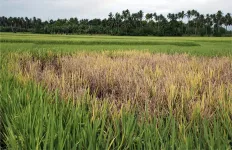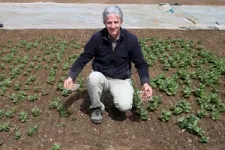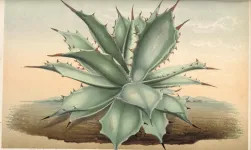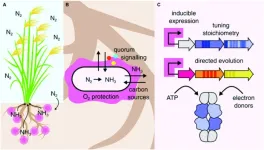(Press-News.org)
Rice is one of the most important crops in the world and constitutes the primary food source for over half of Earth’s population. Protecting rice plantations from disease is therefore an essential endeavor in modern agriculture. Of the many pathogens that can infect rice plants, the bacterium Xanthomonas oryzae, which is responsible for bacterial blight (BB), is among the worst. Hundreds of millions of dollars’ worth of crops are lost each year due to BB, and millions of dollars are spent in preventive measures and research.
One of the most fruitful strategies to control BB and other crop diseases is to grow genetically resistant cultivars. However, as pathogens can evolve rapidly, researchers have to constantly explore new genes that grant resistance and apply them when breeding. Hence, they have to regularly sample multiple rice plants at different times of the year and measure their response to bacterial infection, which represents manually intensive and time-consuming labor.
But what if we leveraged modern technologies to greatly simplify this process? In a recent study made available online on 29 December 2022 and subsequently published in volume 5 of Plant Phenomics on 16 January 2023, a research team led by Dr. Xuping Feng from Zhejiang University, China, developed an innovative strategy that combines drones and machine learning to both gauge BB outbreaks in the field and screen for potentially resistant genes.
The researchers set up two experimental sites in Zhejiang Province, China, where they grew over 60 types of rice cultivars with different resistance to BB. Using unmanned aerial vehicles (UAVs, better known as ‘drones’) equipped with regular and multispectral cameras, they imaged the crop sites at different stages of rice plant development. Afterwards, they combined these UAV images with accumulated temperature (AT) data and used them to train a deep learning model to evaluate the severity of BB.
Worth noting, fusing AT data with UAV imaging data taken at different stages of rice plant growth was a strategy unique to this study. The team found that this information was enough for the trained model to make accurate predictions about BB severity. Moreover, the researchers also tested whether a model trained with data gathered at one site could be supplied with a small amount of training data gathered at a different site to improve its predictions on the latter. Fortunately, their results were very promising, as Dr. Feng observes: “Considering the cost of field sampling, we found that a transfer of only 20% of new data was a useful and cost-effective model updating strategy to achieve reliable predictions of BB severity across different sites.”
The researchers then sought to use this new method for effectively measuring BB severity using UAVs to perform quantitative trait loci (QTL) mapping. “QTL mark the location in the genome where a gene controls specific quantitative traits, such as susceptibility to a disease. Mapping QTL to crop responses under pathogen stress can help breeders identify the functions or traits of crops that a given set of QTLs controls,” explains Dr. Feng. Put simply, QTL mapping involves analyzing the genome of multiple samples of an organism and trying to pinpoint which genes could be responsible for a target trait, including disease resistance.
In this study, the team determined BB disease severity in the crops indirectly using UAV images and combined this information with the results of genetic analysis of multiple rice samples taken at different growth stages and from different cultivars. Through this approach, the researchers managed to detect both previously identified QTLs related to BB resistance, as well as three new ones!
As shown by the results, the overall strategy outlined in the study could become a real time saver in agricultural disease research. “Compared with manual measurements of disease severity, UAV remote sensing techniques enable us to gather large-scale phenotypic information rapidly, which provides technical support for accelerating breeding research,” concludes Dr. Feng. Most importantly, while the approach was developed and tested specifically for rice and BB, it could be adapted to other crops and diseases as well.
With any luck, implementing innovative ideas such as this one in real plantations all over the world will help us secure our food sources and minimize crop losses due to disease.
###
Reference
Authors
Xiulin Bai1, Hui Fang2, Yong He1, Jinnuo Zhang1, Mingzhu Tao1, Qingguan Wu1, Guofeng Yang1, Yuzhen Wei3, Yu Tang4, Lie Tang5,
Binggan Lou6, Shuiguang Deng7, Yong Yang8, and Xuping Feng1
Affiliations
1College of Biosystems Engineering and Food Science, Zhejiang University
2Huzhou Institute of Zhejiang University
3School of Information Engineering, Huzhou University
4Academy of Interdisciplinary Studies, Guangdong Polytechnic Normal University
5Department of Agricultural and Biosystems Engineering, Iowa State University
6College of Agriculture and Biotechnology, Zhejiang University
7College of Computer Science and Technology, Zhejiang University
8State Key Laboratory for Managing Biotic and Chemical Treats to the Quality and Safety of Agro-Products, Key Laboratory of Biotechnology for Plant Protection, Ministry of Agriculture, and Rural Affairs, Zhejiang Provincial Key Laboratory of Biotechnology for Plant Protection, Institute of Virology and Biotechnology, Zhejiang Academy of Agricultural Science
END
BOSTON – Mass General researchers have discovered a novel molecular mechanism responsible for the most common forms of acquired hydrocephalus, potentially opening the door to the first-ever nonsurgical treatment for a life-threatening disease that affects about a million Americans. As reported in the journal Cell, the team uncovered in animal models the pathway through which infection or bleeding in the brain triggers a massive neuroinflammatory response that results in increased production of cerebrospinal fluid (CSF) ...
About The Study: Child firearm assaults increased substantially during the COVID-19 pandemic in four major U.S. cities, according to the results of this study. Racial and ethnic disparities increased, as Hispanic, Asian, and especially Black children experienced disproportionate shares of the increased violence.
Authors: Jonathan Jay, Dr.P.H., J.D., of the Boston University School of Public Health in Boston, is the corresponding author.
To access the embargoed study: Visit our For The Media website at this link https://media.jamanetwork.com/
(doi:10.1001/jamanetworkopen.2023.3125)
Editor’s ...
Curtin researchers have uncovered new evidence of western pygmy possums interacting with native flowers, providing the first eDNA study to simultaneously detect mammal, insect and bird DNA on flowers.
The new research, published today in Environmental DNA, examined DNA traces left by animal pollinators on native flora and detected both insect and animal pollinators from multiple flowering plant species at once - a game changer in the face of declining animal pollinators globally.
In North America, some pollinator species have fallen by more than 95 per cent while ...
The 2023 SIAM Conference on Computational Geometric Design, organized by the SIAM Activity Group on Geometric Design, is part of the International Geometry Summit bringing together the Symposium on Physical and Solid Modeling 2023, Shape Modeling International 2023, EG Symposium on Geometry Processing 2023, and Geometric Modeling and Processing 2023.
The 2023 SIAM Conference on Computational Geometric Design seeks high quality, original research contributions that strive to advance all aspects ...
The link between symptoms of COVID-19 and physical inactivity is increasingly evident. An article recently published in the journal Scientific Reports by researchers at the University of São Paulo (USP) in Brazil describes a study in which COVID-19 survivors with at least one persistent symptom of the disease were 57% more likely to be sedentary, and the presence of five or more post-acute sequelae of infection by SARS-CoV-2 increased the odds of physical inactivity by 138%.
“Although this was a cross-sectional study, the findings underscore the importance of discussing and encouraging physical activity at all times, including during the pandemic,” ...
Mezcal is a distilled alcohol made from the boiled and fermented sap of agave plants. Most mezcal beverages — including all brands of tequila — are sold as pure distillates, but a few have an added stowaway bottled inside: worms.
Called gusanos de maguey (Spanish for agave worms), these odd organic chasers aren’t actually worms, but instead a type of insect larva, and their addition to mezcal is a recent one. Mezcal production has a storied history, dating back to the first Spanish inhabitants of Mexico, but larvae were only added to the drink in ...
WASHINGTON, March 8, 2023—The American Educational Research Association (AERA) has announced the selection of 24 exemplary scholars as 2023 AERA Fellows. The AERA Fellows Program honors scholars for their exceptional contributions to, and excellence in, education research. Nominated by their peers, the 2023 Fellows were selected by the Fellows Committee and approved by the AERA Council, the association’s elected governing body. They will be inducted during a ceremony at the 2023 Annual Meeting in Chicago on April 14. They join a total of 714 AERA Fellows.
“AERA Fellows demonstrate the highest standards ...
Fertilizers are one of the main reasons that we are able to grow enough crops to feed the almost 8 billion humans living on Earth. Modern agriculture depends largely on nitrogen-based fertilizers, which significantly increase the yield of crops. Unfortunately, a great portion of these fertilizers are produced at an industrial level, consuming fossil fuel energy and causing nitrogen pollution.
One attractive way to minimize our use of industrially produced fertilizers is to harness the power of nitrogenases. ...
Research from the University of Cincinnati finds a lack of federal funding for incarceration-related research. The study looked at data from the Department of Justice, National Institutes of Health (NIH) and National Science Foundation, some of which dated back to 1985.
The study was published recently in the journal JAMA Network Open.
“We have very little evidence-based research on how and when to intervene with children and families when someone is removed from the home due to incarceration, especially on how to ...
PET, the plastic used to make bottles, for example, is ubiquitous in our natural environment. In a joint study, scientists from Leipzig University and the Helmholtz Centre for Environmental Research (UFZ) investigated the negative effects that tiny plastic PET particles can have on the metabolism and development of an organism. Their findings have now been published in the journal Scientific Reports.
The increasing use of plastic is threatening ecosystems around the world. One of the big concerns is the presence of plastics in the form of small particles, also called microplastics and nanoplastics. ...





